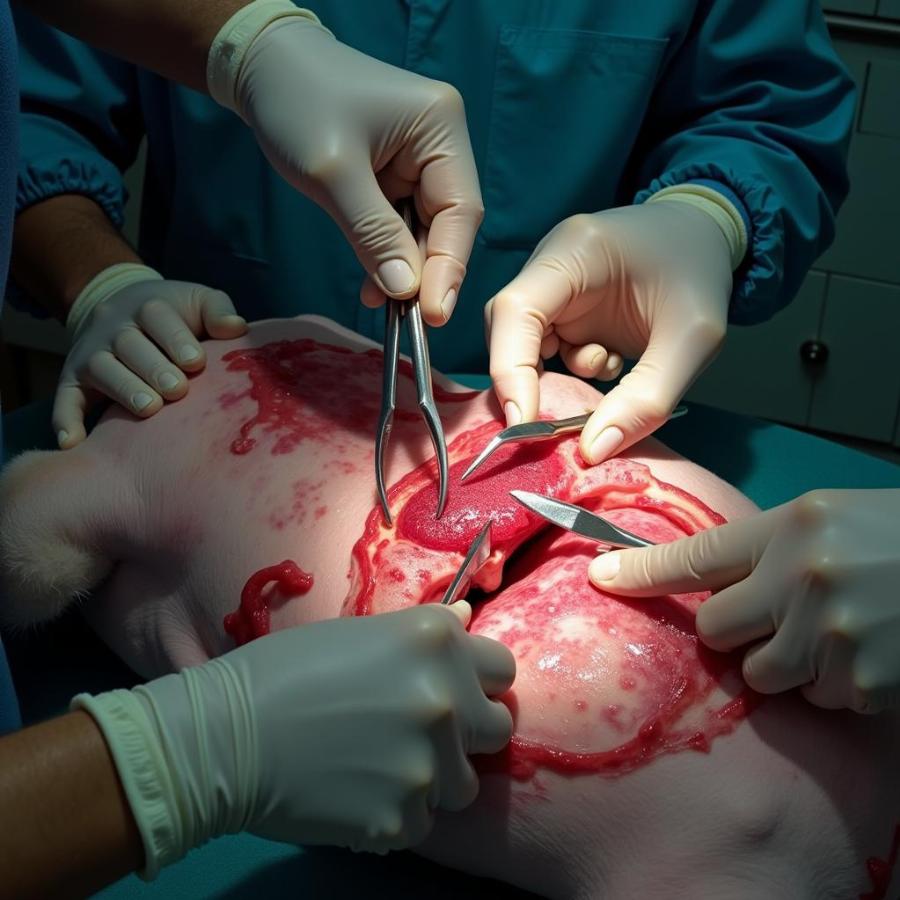Splenic enlargement in dogs, also known as splenomegaly, is a serious condition that requires immediate veterinary attention. This comprehensive guide will explore the causes, symptoms, diagnosis, and treatment options for splenic enlargement in dogs, empowering owners with the knowledge they need to navigate this challenging health issue. Understanding this condition can be crucial for early detection and intervention, potentially saving your dog’s life.
What Causes Splenic Enlargement in Dogs?
Splenic enlargement can be triggered by a variety of underlying issues, ranging from infections and immune-mediated diseases to various types of cancer. Some common causes include:
- Infections: Bacterial, viral, and parasitic infections can cause the spleen to enlarge as it works overtime to filter out the infectious agents.
- Immune-Mediated Diseases: Conditions like immune-mediated hemolytic anemia (IMHA) and immune-mediated thrombocytopenia (ITP) can lead to splenic enlargement.
- Cancer: Several types of cancer, including hemangiosarcoma, lymphoma, and mast cell tumors, can affect the spleen, causing it to grow larger.
- Trauma: A blunt force trauma to the abdomen can damage the spleen and lead to enlargement or even rupture.
- Certain Medications: Some medications can have splenic enlargement as a side effect.
Recognizing the Symptoms of Splenic Enlargement
Splenic enlargement in dogs often presents with subtle or nonspecific symptoms, making early diagnosis challenging. Some signs to watch out for include:
- Lethargy and Weakness: Your dog may seem tired and less playful than usual.
- Decreased Appetite: Loss of interest in food can be an indicator of several underlying health problems, including splenic enlargement.
- Abdominal Distension: A swollen or bloated abdomen can be a sign of an enlarged spleen.
- Vomiting and Diarrhea: These gastrointestinal issues can accompany splenic enlargement.
- Pale Gums: Pale gums can indicate anemia, which can be a consequence of certain spleen-related conditions.
- Increased Thirst and Urination: Changes in drinking and urination habits may suggest a problem.
Diagnosing Splenic Enlargement: What to Expect
Your veterinarian will conduct a thorough physical examination, paying close attention to your dog’s abdomen. Diagnostic tests may include:
- Blood Tests: Complete blood counts (CBC) can reveal abnormalities like anemia or changes in white blood cell counts.
- Urinalysis: Examining urine can provide clues about kidney function and other potential issues.
- X-rays and Ultrasound: These imaging techniques allow visualization of the spleen and surrounding organs, helping to determine its size and shape.
- Fine-Needle Aspiration (FNA) or Biopsy: Collecting a sample of splenic tissue for microscopic examination can help determine the cause of enlargement.
Treatment Options for Splenic Enlargement in Dogs
Treatment for splenic enlargement depends on the underlying cause. Options may include:
- Medications: Antibiotics for infections, immunosuppressants for immune-mediated diseases, and chemotherapy for cancer.
- Surgery: Splenectomy (surgical removal of the spleen) is often necessary, especially in cases of cancer or rupture.
- Supportive Care: Fluid therapy, pain management, and nutritional support can help manage symptoms and improve quality of life.
 Treating Enlarged Spleen in Dogs
Treating Enlarged Spleen in Dogs
What is the Prognosis for Dogs with Splenic Enlargement?
The prognosis varies depending on the underlying cause. Early diagnosis and appropriate treatment are crucial for the best possible outcome.
How Can I Prevent Splenic Enlargement in My Dog?
While not all causes of splenic enlargement are preventable, maintaining your dog’s overall health through regular veterinary checkups, vaccinations, parasite prevention, and a balanced diet can help minimize the risk of some contributing factors.
Conclusion
Splenic enlargement in dogs is a serious condition requiring prompt veterinary attention. By understanding the causes, symptoms, diagnostic process, and treatment options, you can be a proactive advocate for your dog’s health. Early intervention can significantly impact the outcome and improve your furry friend’s quality of life.
FAQ:
- Can a dog live without a spleen? Yes, dogs can live a normal life after splenectomy, although they may be slightly more susceptible to certain infections.
- What is the average cost of splenectomy in dogs? The cost can vary depending on location and the complexity of the case, but it typically ranges from $1,000 to $3,000.
- What are the signs of a ruptured spleen in dogs? Signs of a ruptured spleen include sudden collapse, pale gums, weakness, rapid breathing, and a distended abdomen. This is a life-threatening emergency.
- Is splenic enlargement always cancerous? No, splenomegaly can be caused by various factors, not just cancer. Diagnostic testing is necessary to determine the underlying cause.
- How can I monitor my dog after splenectomy? Follow your veterinarian’s instructions regarding post-operative care, including medications, activity restrictions, and follow-up appointments.
splenomegaly in dogs
spleen burst in dogs
dog enlarged spleen
dog abdominal ultrasound
Beaut Dogs is your trusted source for comprehensive information on dog breeds, health, and care. For personalized guidance and support, contact us at Email: [email protected]. We are committed to helping you provide the best possible care for your beloved canine companion. Visit Beaut Dogs today to explore a wealth of resources and learn more!